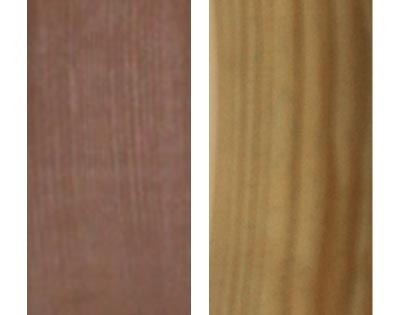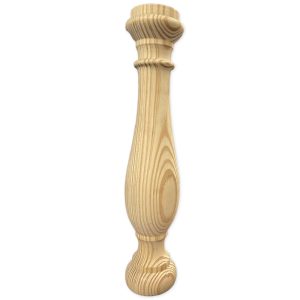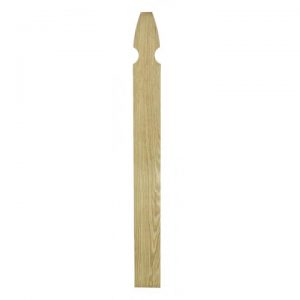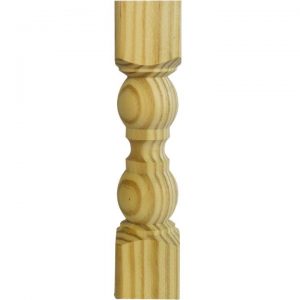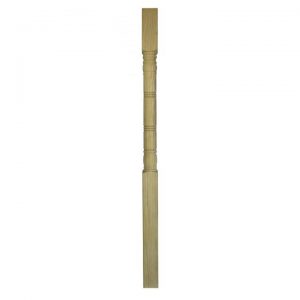Having trouble deciding between cedar and pressure treated lumber? Keep reading for some important information on both the cedar and pressure treated wood that we use for our products.
Myths and Misconceptions about Western Red Cedar
Many of us don’t like the idea of cutting down trees, but recently western red cedar, inland cedar, and other cedar forests have been managed smartly and responsibly. Over the years, the growing time for forests has been greatly reduced, and the tiny amount of resulting waste is used as soil for the next generation of trees. Red cedar lumber has a low environmental impact and is very sustainable, making it ideal for “green” construction.
Why We Use Western Red Cedar

The following are the top reasons that S&L Spindles chooses western red cedar over other types of cedar.
Durability
We specifically use western red cedar because of its strength compated to other types of wood, and we only use wood that has been kiln dried. Cedar offers low density and shrinkage factors, and exceptional thermal insulation value.
Different from Standard Cedar
As always, our western red cedar has a smooth surface and a very few small, tight knots. Cedar sold at most lumber yards and home improvement stores tends to be rough and knotty.
Stands Up Better in the Elements
Often used outside, western red cedar holds paint well and is very weather resistant. In fact, western red cedar is one of the few wood species that are naturally at home outdoors. Properly finished, western red cedar will last for decades, even in harsh environments. Its natural resistance to moisture, decay, and insect damage make it the ideal choice for a surface that is exposed to sun, rain, heat, and cold all year round.
Cedar Workability
Western red cedar produces long, lightweight lengths of timber with a fine, straight grain and uniform texture that makes it easy to cut, saw and nail with common tools. These features also contribute to its ability to be planed to a smooth surface or machine-cut to any pattern. The lack of pitch and resin allows western red cedar to hold glue bonds from a wide range of adhesives and provide a firm base for many types of paints and stains.
Indoor/Outdoor Versatility
Cedar makes an excellent choice for either interior or exterior home use. Cedar fibers in the heartwood contain natural preservatives that are toxic to decay-causing fungi. The tree’s ability to produce these extractives increases with age, making the outer regions of heartwood the most durable.
Myths and Misconceptions about Pressure Treated Lumber
When people hear the words “pressure treated,” most think of the green, dark, and wet wood that you sometimes see in larger stores. However, the pressure treated lumber we use at S&L Spindles is machine after-treated, meaning our raw material is dry before we make the product itself. This makes all of our pressure treated products dry and ready to paint or stain immediately after installation.
Why We Use Southern Yellow Pine as Our Pressure Treated Wood
S&L Spindles chooses southern yellow pine as our pressure treated wood. Here are some of the top reasons why.
Readily Available
Southern yellow pine is grown in abundance and easy for us to get, with a big swath of it growing across the Southern United States, from Texas up to Virginia. Most of the yellow pine (PT) and cedar is purchased from certified SFI lumber mills. This tells you that we’re buying products from a certified forest or certified sourcing. For every tree that is harvested, two or more trees are planted to replace it.
Our Products Are Machine After Treated
Machined after treatment, also known as kiln dried after treatment, ensures that the wood is completely dry and moisture-free. Because of MAT, products from yellow pine are nonwarping, do not crack as easily, and are easily paintable. The paint won’t peel because it is already dry.
Low Cost
Yellow pine is the the most economical lumber. Because of the large supply of southern yellow pine, we use it so we can pass on the lower price of the material to our customers.
High Density and Stability
This species of wood has the highest density of all structural lumber, giving the builder a higher load-bearing capacity and stronger holding power. It is also the easiest to install and won’t split in the ends very easily, as it is a softwood lumber. Southern yllow pine is one of most durable and strongest softwoods available. Additionally, southern pine dimension lumber 2″ and less in thickness must be dried to a maximum moisture content of 19%. This minimizes shrinkage that you’ll see with other lumber and gives you long-lasting stability.
Western red cedar and pressure treated pine both make excellent wood choices for your project.
Having trouble deciding between cedar and pressure treated lumber? Keep reading for some important information on both the cedar and pressure treated wood that we use for our products.

